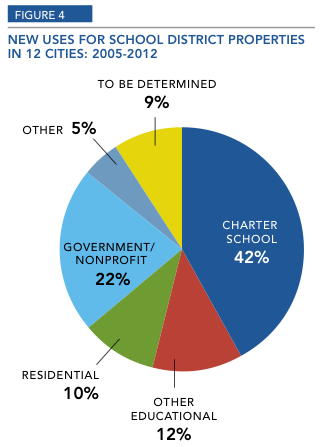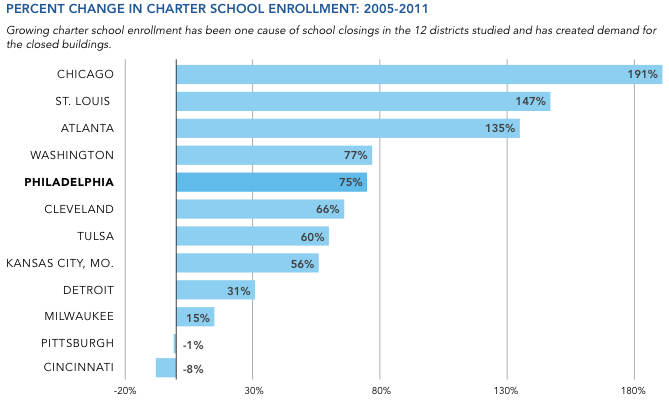One of the ongoing tensions in the Chicago school closure debate has been the fear that the closing of public schools isn't just a response to declining enrollment in neighborhoods that have shed school-age population (and most, though not all, are):
But the internal document, prepared at a time when school leaders faced a December deadline to make their decisions public, lays out multiple scenarios for closing neighborhood schools and adding privately run charters — a key component of Emanuel's plans for improving public education. Chicago Teachers Union members, aldermen and other charter school critics have accused the administration of favoring the charters while depriving schools in poor neighborhoods of needed improvements.
This is based in recent history. Pew recently took a look at what several big-city school districts, Chicago included, have done with shuttered school buildings (PDF). Reuse as charter schools has been the most frequent:

It's hard to unload a school building, as Pew found. They're not just big, old, intended to be single-use, and expensive; closing schools tend to follow population decline, which means the buildings are often in generally declining neighborhoods that are not only undesirable on the real estate market but surrounded by plenty of other vacant buildings. WBEZ's Elliot Ramos made an excellent series of maps that shows how the schools on the CPS's current list also cluster near abandoned properties and city-owned vacant lots. Be sure to scroll down to the last map, which shows just how dense those can be. So it's not too surprising that the buildings are recycled into other government uses, including charter schools.
The Pew Report also demonstrated just how much the Chicago charter-school population has spiked in recent years.

This did make me wonder how Chicago's charter school population compares to other cities in its weight class (Phoenix, as a result of its massive annexation, is covered by double-digit school districts, so I left it out). It turns out that, despite the big percentage increase, we're near the bottom (all data from the National Alliance for Public Charter Schools for 2011-2012):
New York: 4.7%
San Francisco: 5.9%
Atlanta: 10.3%
Chicago: 11.1%
Dallas: 11.7%
Los Angeles: 14.9%
Houston: 17.8%
Philadelphia: 23.4%
San Antonio: 25.6%
St. Louis: 31.1%
Detroit: 33.7%
Washington, D.C.: 41.1%
New Orleans: 76.3%


